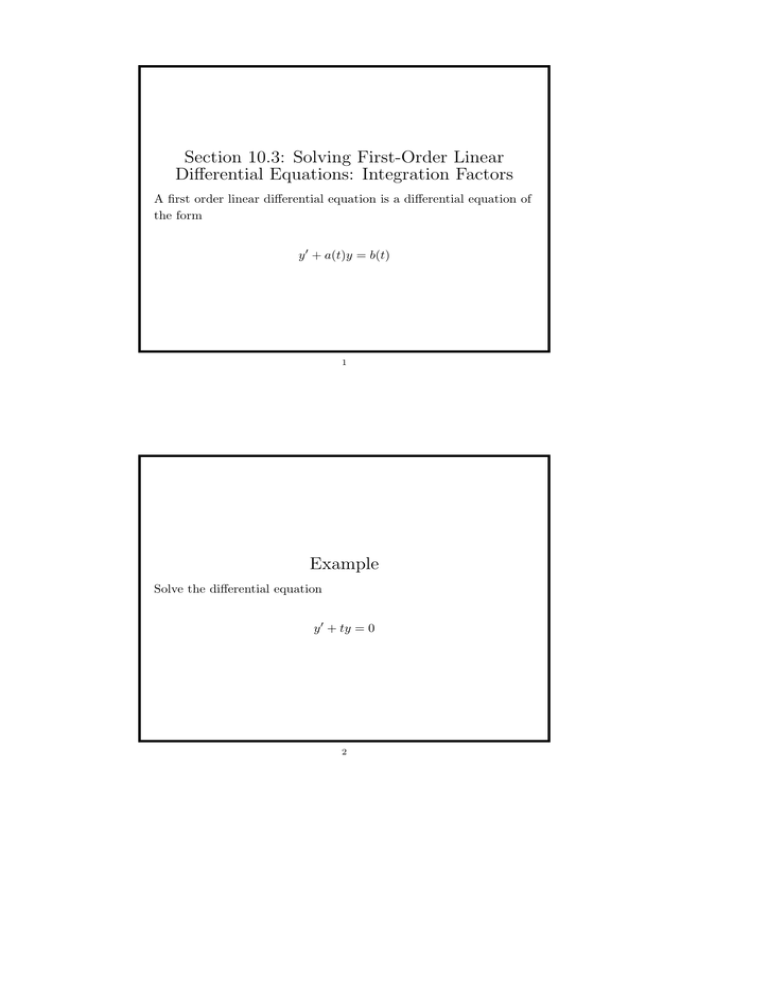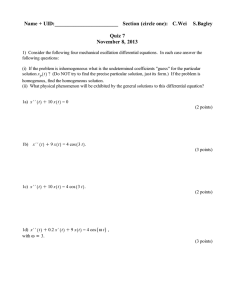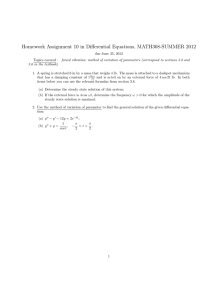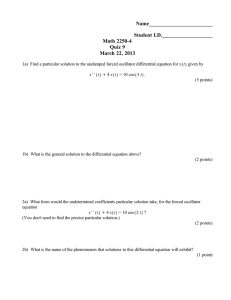Solving First-Order Linear Differential Equations: Integration Factors
advertisement

Section 10.3: Solving First-Order Linear Differential Equations: Integration Factors A first order linear differential equation is a differential equation of the form y 0 + a(t)y = b(t) 1 Example Solve the differential equation y 0 + ty = 0 2 Solution In this case we can use the method of separation of variables. If y is constant, then ty ≡ y 0 ≡ 0 so that y ≡ 0. Otherwise, we may express the equation as Integrating with respect to t, we have 1 − T2 2 Z y0 y = −t. Let C = y(0). T −tdt = 0 Z = 0 Z T y 0 dt y y(T ) dy y C y(T ) | ln | C = = 3 Solution, continued (As our solution must be continous and cannot take the value zero, the signs of y(T ) and C = y(0) must agree. So, we may drop the absolute value bars.) Exponentiating both sides of this equation and multiplying by C, −1 2 we obtain y(T ) = Ce 2 T . 4 Another Example Solve the differential equation y 0 + y = 10e−t 5 Solution In this case, we cannot apply the separation of variables technique. However, as et is never equal to zero, the solutions to the original equation and to the equation et y 0 + et y = 10 are the same. Observe that d t (e y) dt = et y 0 + et y 6 Solution, continued Thus, if our differential equation holds, we have d t dt (e y) = 10. We integrate with respect to t. eT y(T ) − y(0) = et y(t)|t=T t=0 Z T d t = (e y)dt 0 dt Z T = 10dt 0 = 10T So, if we write C = y(0), then we have y(T ) = 10e−T T + Ce−T . 7 A Third Example Solve the differential equation 1 y 0 + y = cos(t) t 8 Solution In this case, multiplying by t we may express the equation as ty 0 + y = t cos(t). Using the product rule we check that d 0 dt (ty) = ty + y. We integrate this expression. Note: The original equation is singular at t = 0 in the sense that the function 1t is not defined. We need to take for the lower limit of integration some other constant. The number π is a convenient choice in this case. 9 Solution, continued Z T y(T ) − πy(π) T = π T d (ty)dt dt Z = t cos(t)dt π = t sin(t) + cos(t)|t=T t=π integrate by parts with u = t and dv = cos(t)dt = T sin(T ) + cos(T ) + 1 Write C := y(π). Then we conclude that y(T ) = sin(T ) + 1 T (cos(T ) + 1 + πC). 10 General Solution In general, if A0 (t) = a(t), then d A(t) (e y) dt = eA(t) y 0 + A0 (t)eA(t) y = eA(t) (y 0 + a(t)y) Thus, a differential equation of the form y 0 + a(t)y = b(t) may be d expressed as dt (eA(t) y) = eA(t) (y 0 + a(t)) = eA(t) b(t). 11 General solution, continued So, if α is in the domain of the functions a(t) and b(t), we have A(T ) e A(α) y(T ) − e Z y(α) T = α T Z d A(t) (e y)dt dt eA(t) b(t)dt = α Set C := eA(α) y(α), then Y (T ) = e−A(T ) 12 RT α eA(t) b(t)dt + Ce−A(T ) . An example reconsidered In solving the equation y 0 + 1t y = cos(t), we multiplied by t and d then observed that dt (ty) = ty 0 + y = t(y 0 + 1t y). In terms of the general solution, a(t) = we have A0 (t) = a(t). 1 t and if A(t) = ln |t|, then Note that eA(t) = eln |t| = |t|. So, multiplying by t is the same as multiplying by eA(t) for t > 0. Our general method gives y(T ) −A(T ) Z T = e eA(t) b(t)dt + Ce−A(T ) α = 1 T Z T t cos(t)dt + α αy(α) T To finish, we must choose α and evaluate the above integral. 13




